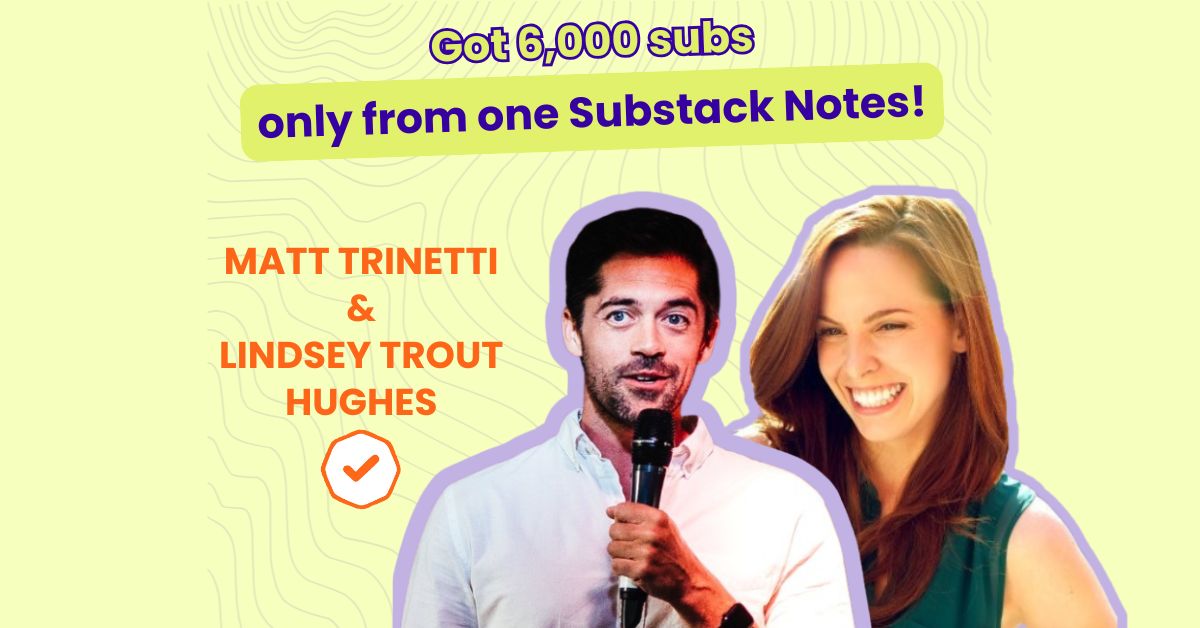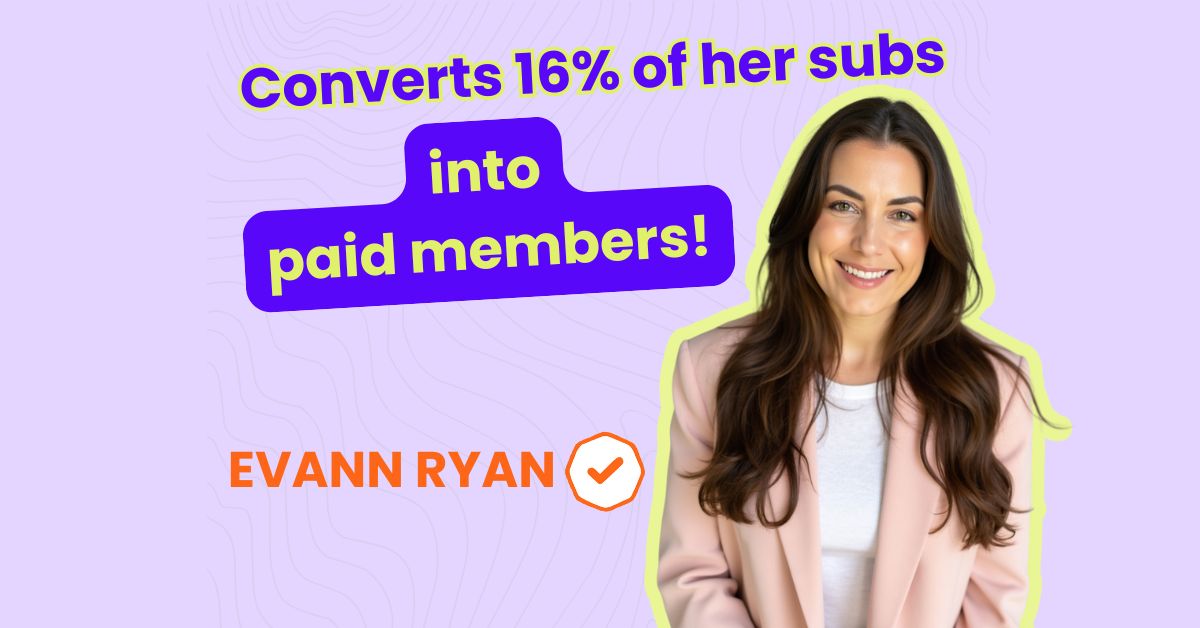Interview Date: 23 March, 2025
Table of Content
- Meet Caroline Danks
- Newsletter Identity Card
- Tools she uses to run her newsletter
- How she started The Nest Egg along with her business partner
- How she grew over 3,000 subcribers
- Her paid subscription strategies to become a Substack bestseller
- Personal & professional impact of running a newsletter
MEET THE CREATOR
Caroline and Tony are the dynamic duo behind LarkOwl, where they help non-profit leaders build sustainable organizations with diverse income streams.
In 2019, alongside their consultancy, Caroline launched a newsletter to share her deep expertise in fundraising. Initially writing on Mailchimp, she made the switch to Substack in November 2023—a move that helped propel her newsletter, The Nest Egg, to Substack’s bestseller status.
Caroline is embracing the challenges of their niche and navigating the limitations of her business model. Building her newsletter with this awareness has also helped her grow an engaged audience of over 3,000 subscribers and 100+ paid members.
In this interview, we’ll dive into:
- How they integrated a newsletter to their business and position it as their signature (and only) product.
- Their growth strategies that led to 3,300+ subscribers
- How they approached paid subscriptions as a digital product launch
- 6 key actions that made them a Bestseller
- The limitations of writing within a specific niche and how to manage expectations
Enjoy!
NEWSLETTER IDENTITY CARD
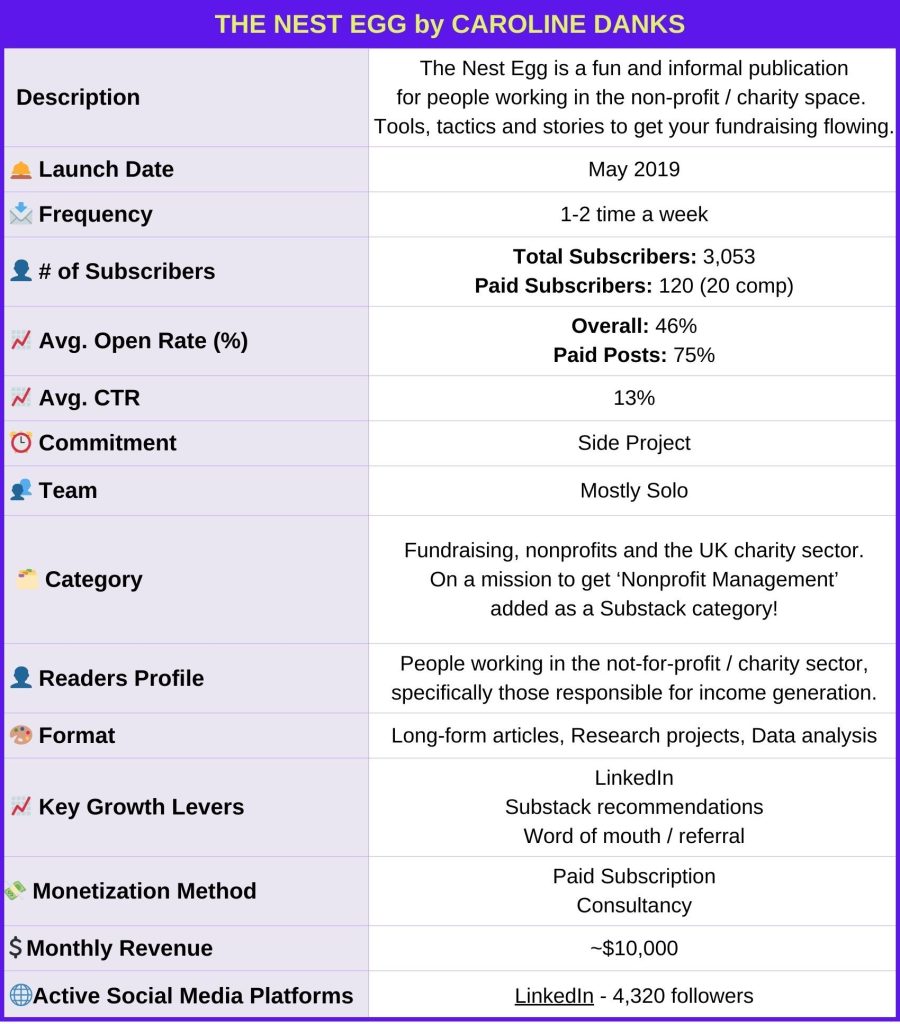
TOOL STACK
- ESP: Substack
- Task Management: Happy Planner
- Productivity: Happy Planner
- Growth: LinkedIn
- Webinars: Zoom
- Payments: Stripe
START
You and Tony run a business called LarkOwl (see here) where you provide trusts, major gifts and commercial income through consultancy to non-profits. How and why did you start The Nest Egg in the first place? How do you position your newsletter besides your main business?
LarkOwl took flight in 2019 and is the amalgamation of my and Tony’s solo freelance businesses. We provide consultancy services to charities and non-profits, supporting specifically with income generation.
The Nest Egg has existed since 2019, initially hosted on Mailchimp and from November 2023 on Substack. Its role was initially to help us to scale beyond consultancy (through products, courses, workshops, and affiliate income). However, we’ve now settled on a simpler business model which consists of consultancy and The Nest Egg as our signature (and only) product.
Our subscribers are professional fundraisers working in (mostly) UK charities. We also attract CEO’s and trustees who are directly responsible for income generation and the sustainability of the charities they run.
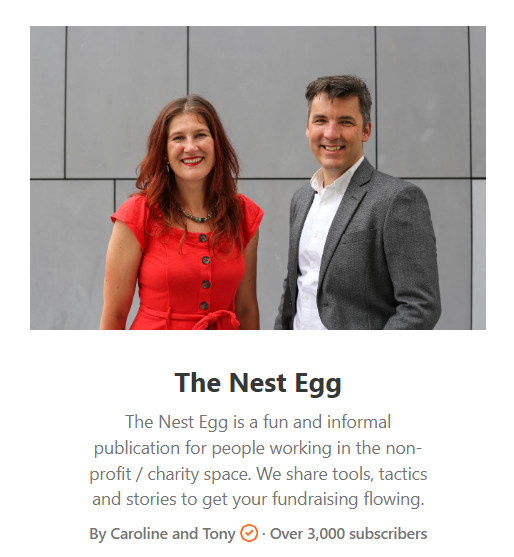
GROWTH
Which strategies did you use to grow over 3,000 subscribers?
We started The Nest Egg in 2019 over on Mailchimp and have grown our audience over nearly 6 years. Growth was fast in the early years as we promoted a lead magnet which was in high demand (and remains so) in our sector (a study into the return on investment for different types of fundraising in UK charities).
For any fundraising data geeks out there, you can download the report from our website.
Over the years we’ve hosted webinars and workshops, created and sold online courses, appeared on podcasts, spoken at events, written for industry publications and curated a conference for a third party provider, all of which have helped to grow our audience. We also rely heavily on word of mouth/referral (it’s a very small world where everyone tends to know each other).
We became conscious that the people downloading our lead magnet and populating our email list weren’t necessarily the people buying our products. In 2023 we made the report freely accessible on our website, without the need for people to submit an email, believing it better that we have a smaller, more aligned list, than a larger list of people unlikely to ever buy anything from us.
It’s important that people actively subscribed because they wanted to receive our writing regularly – not because they were after a one-off freebie.
Additionally, we’ve not updated the report since 2021, so our numbers have plateaued recently. We also clean our list regularly (removing 1,000 people in September 2024 and another 300 at the end of February 2025) so that people on it are truly engaged with our writing.
We’ve just refreshed the Fundraising ROI’s data and will host the new report here on Substack. It will be interesting to see how it impacts growth (we’ll let you know!).
Regarding growth efforts, what would you do differently if you had a chance to start over?
We’d probably ensure that our lead magnet was directly related to the products we were trying to sell.
For many years there was a mismatch. But we’re now confident that our updated report (coming April 2025) will entice professional fundraisers to subscribe to The Nest Egg and that our free and paid content is accurately targeting the right audience.
MONETIZATION
Your newsletter is a Substack Bestseller with 120 paid subscribers. When did you launch your paid subscription and how did you decide that it was the right time for you to activate it?
After several issues with email deliverability in 2023, plus a desire to simplify our business model, we moved our list to Substack in November 2023.
We explained to our audience (multiple times) that we’d be moving from weekly to monthly newsletters from January 2024, but that by paying for a subscription, they could continue to receive weekly articles from us.
Most of our audience engage with The Nest Egg as they would an email delivered through more traditional email marketing software. We’ve had to educate them as to how Substack differs.
How did you gain your first 10 paid subscribers?
We treated the paid subscriptions to the Nest Egg like any other digital product launch and sent lots of emails about it. Because we’d prepared our audience (and we had an email list of 3,035 in January 2024), we had 20 sign ups as soon as we turned on paid.
What are your strategies to convert free subscribers into paid ones or gain new paid subscribers? Among various strategies you’ve tried so far, which ones work best to grow your paid subscribers list?
We know our audience intimately because, like them, we too are fundraisers working in UK charities – yet we have a unique viewpoint as consultants who work with multiple clients at once, so it’s easy for us to see trends and to report back on them.
Our best strategy is to produce quality content, which we know people want to read (mini research projects and data deep dives alongside strong opinions tend to do well).
- In February 2024, we offered 220 engaged readers a month’s complimentary upgrade – after which 5 became paying subscribers.
- In September, I reached out to 3 other publications in our (very small) nonprofit sector niche and asked for mutual recommendations. All agreed and we’ve seen some good growth as a result (over 500 new free subscribers in 6 months).
- In November 2024, I did a LinkedIn challenge, posting daily on LinkedIn to promote The Nest Egg.
- We also posted two (very juicy) behind-the-scenes deep dives which converted well. One post went viral which saw us gain 100 new subscribers in a day. Over the month we gained over 20 new paid subscribers.
- Our annual price rise from February 2025 converted 26 subscribers to paying during January 2025 (clearly they wanted to lock in the lower price).
- We repeated the LinkedIn challenge in February and gained another 7 paid subscribers which was surprising given the recent price rise.
It’s also worth mentioning what we don’t do. We’re very intentional in our recommendations and try to keep the list small (recognising that many people in our audience are very busy, we don’t want to overwhelm them).
Apart from the planned annual price rise, we don’t experiment with pricing and have never really offered discounts in our business (preferring to add value with bonuses if we’re going to do a time limited / special offer).
We’re really trying to stick to principles of simplicity and focus wherever possible.
How did you decide what to offer differently to paid subscribers to make it compelling for them to join as paid members?
We initially chose weekly for paid and monthly for free, mainly because that’s what others were doing and it’s stuck.
For paid subscribers, we tried workshop discounts and a monthly book club and have dabbled a bit in Chat. But it’s the articles that are the heart and soul of The Nest Egg and we’re planning to focus our efforts on delivering great writing for 2025 (and probably beyond).
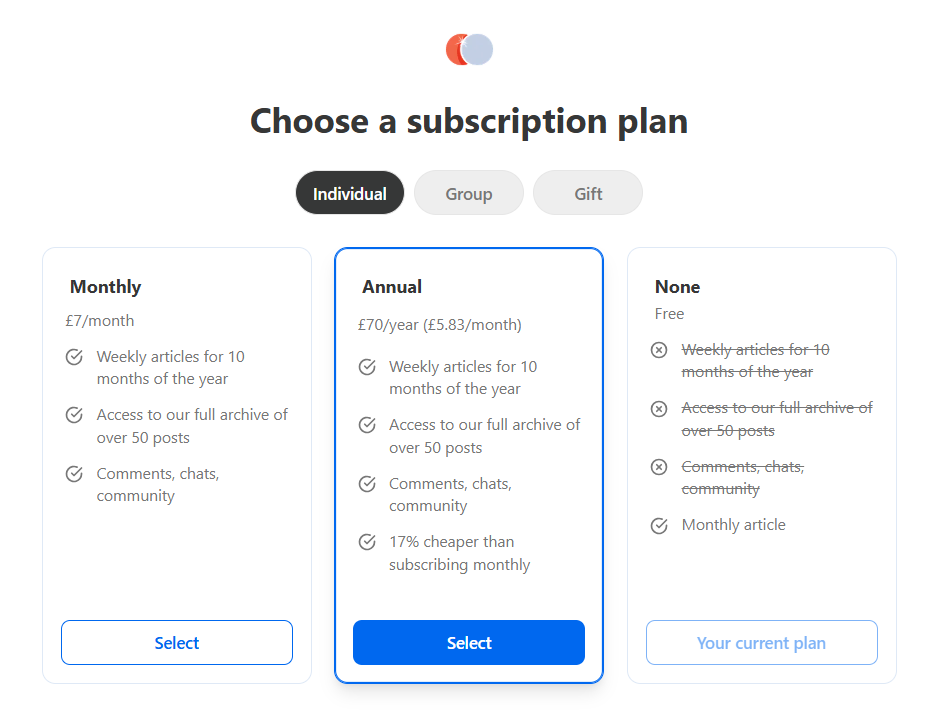
What are your biggest lessons from running a successful paid subscription?
If you want to succeed, you need to shout about your newsletter and show up for it in the same way that you would any other product or service.
There were months during 2024 when I was focused on promoting something else and the lack of new sign ups was noticeable. For 2025, we’re focusing our marketing on The Nest Egg (and nothing else!) and are excited to run several growth experiments to see what works.
It’s important to be realistic about audience size and conversion rates. At the time of writing our audience comprises 3,053 free subscribers and 127 paid – a conversion rate of just over 4%. It’s not enough money yet to sustain our lives, but provides a valuable additional income for something we’d be doing anyway (email marketing).
On the topic of expectation management, I’m conscious of the areas where this business model currently falls short for us specifically (and encourage other creators to do the same so they can mitigate the impact as best as possible). For us, the limitations are:
1. The UK nonprofit sector is quite old fashioned. The idea of a weekly newsletter as a legitimate training product for professional fundraisers is beyond the comprehension of most budget holders (for whom training equals an in person course in London, probably delivered by an older white man that doesn’t swear much). Being an early adopter means doing a lot of work to educate your audience, not just about your subject area, but also around the software you’re using to deliver your product.
2. There can also be a lot of risk aversion / scarcity mindsets – getting people to pay for anything can be a challenge!
3. In addition, nonprofit management isn’t a specific category on Substack. None of the categories really speak to our publication, so we’re not confident there are enough people inside of Substack (yet) to drive growth in a meaningful way for us. This is why we’ve barely used Notes (though we’re excited to try this later in the year though to test our assumptions).
So it’s important to understand your perceived limitations, to test them and to manage your expectations accordingly.
IMPACT & LEARNINGS
How did building The Nest Egg newsletter contribute to your life professionally and personally?
I’ve spent nearly 6 years exploring, testing and trialling online business models in a sector for whom digital training is quite a new and outlandish concept. In that time, I’ve realised what I love to do (and what I don’t) and have settled on consultancy and writing.
By far and away the best bit of selling online courses for me was the email marketing. I love it! Now instead of writing awesome emails in order to sell a product, my emails are the product itself.
I’ve removed a layer of complexity from our business and in doing so have been able to focus on the things I love to do whilst still generating income from multiple sources and supporting our family.
What would it be if you had the right to give one piece of advice to aspiring newsletter creators?
1. Consistency – showing up regularly (not necessarily weekly – choose a schedule which is right for you) helps build trust from your readers and also trust in yourself and confidence in your ability to show up for your writing practice.
2. Authenticity – it may sound a little corny but if I had to choose to veer on the side of personal over-sharing vs maintaining a ‘professional’ veneer, I’d pick the over-sharing every time. Being real and relatable goes a long way.
3. Write for yourself. If you find the process valuable and it helps you be better in your work, then it’s worthwhile and you’ll find the motivation to continue. If others enjoy your content and find it helpful, then its a bonus. Enjoying the process helps take the pressure off.
3 Popular The Nest Egg Issues
- I read TEN sector reports (so you don’t have to)
- Ten places to look for funding for your charity or nonprofit
- Fundraising for core costs
Where to find Caroline and Tony
- “The Nest Egg” Newsletter
- Caroline’s LinkedIn
- Tony’s LinkedIn

